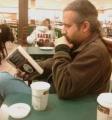If you had to pick one organism with which to tell the story of the modern science of biology, you couldn't do better than to pick the tiny gut bacterium Escherichia coli, commonly called just E. coli. In his latest book Microcosm: E. coli and The New Science of Life,  Carl Zimmer, uses E. coli as a decoder ring to open up the dense and diverse world of biological research, taking us on a panoramic tour of some of the most important conceptual advances and outstanding scientific questions in this important realm of science.
Carl Zimmer, uses E. coli as a decoder ring to open up the dense and diverse world of biological research, taking us on a panoramic tour of some of the most important conceptual advances and outstanding scientific questions in this important realm of science.
Biology, in contrast to a science like physics, is a science of particulars. In physics, if you understand one electron, you understand them all, but in biology every organism is unique. In biology it is more challenging to find universals, to pick an object of study that let's you ask big questions with the hope of finding general answers.
With E. coli we can come quite close: this tiny bacterium is the hydrogen atom of biology, a model simple enough to be experimentally tractable, but representative of general principles that apply to all life. As the pioneering molecular biologist Jacques Monod put it, "What is true for E. coli is true for the elephant," and also true for us. In Microcosm, we follow E. coli through a survey of some of the deep foundations and controversies of biology.
 Melville on Science vs. Creation Myth
Melville on Science vs. Creation Myth Non-coding DNA Function... Surprising?
Non-coding DNA Function... Surprising? Yep, This Should Get You Fired
Yep, This Should Get You Fired No, There Are No Alien Bar Codes In Our Genomes
No, There Are No Alien Bar Codes In Our Genomes







